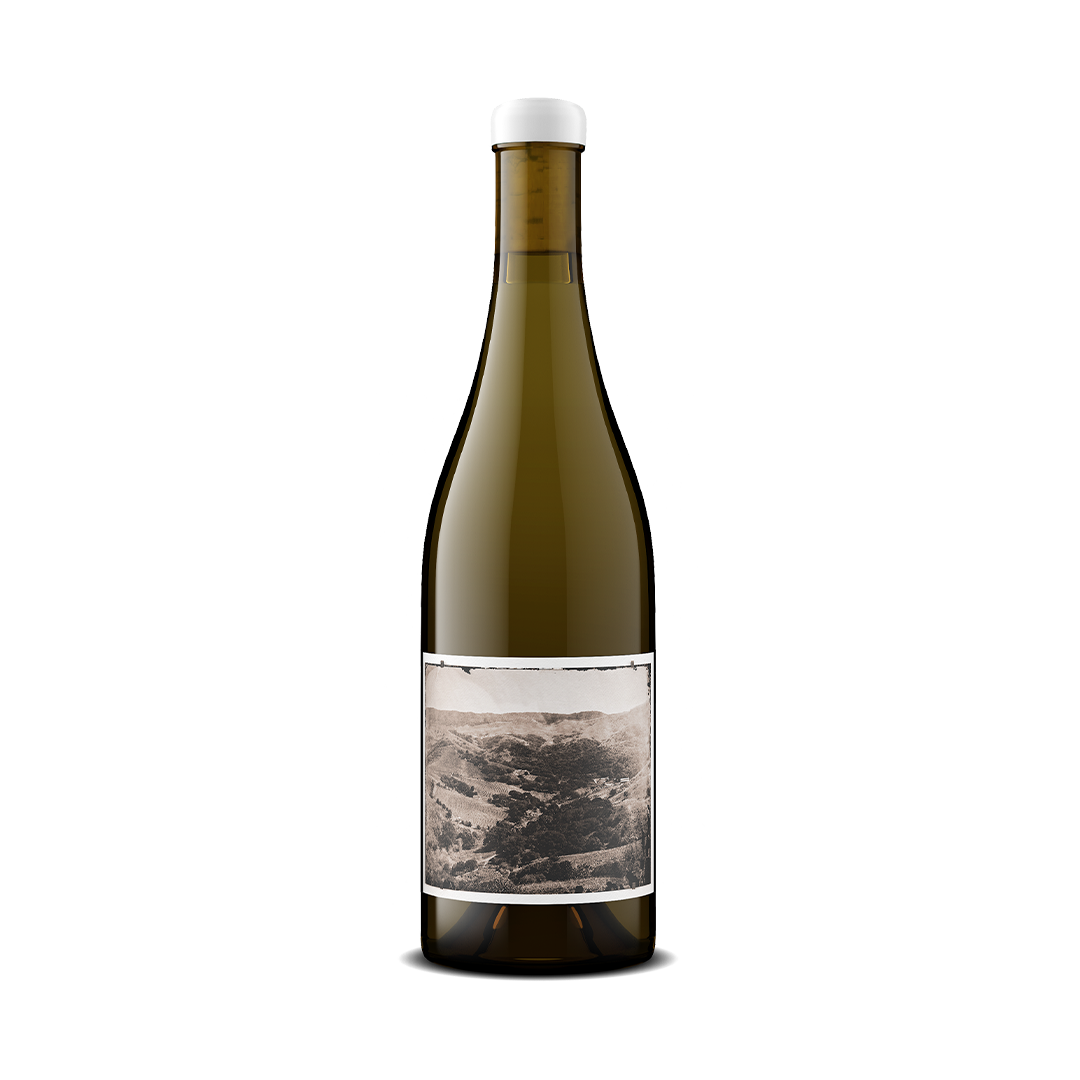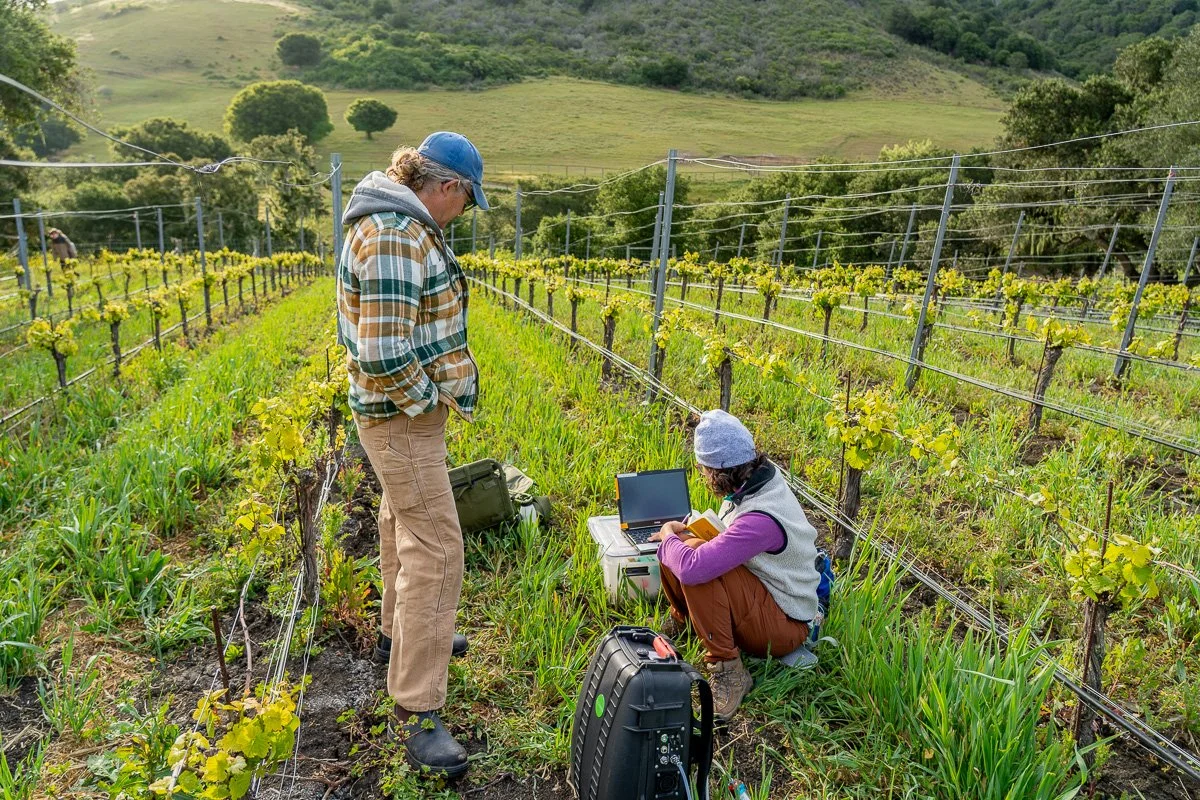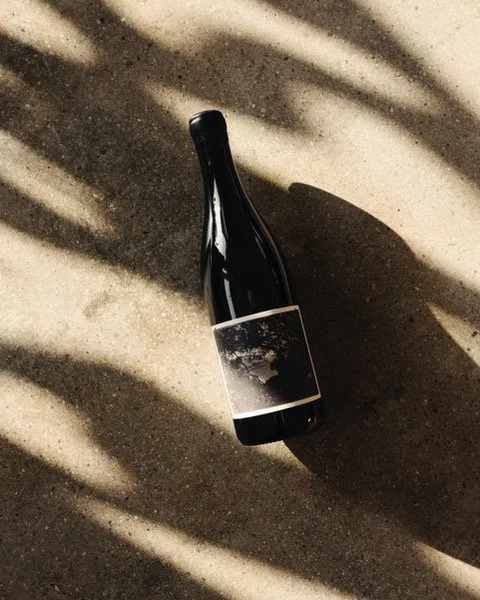
Regenerative Viticulture at Jalama Canyon Ranch
Step into the vineyard at Jalama Canyon Ranch, where a shared vision between Sandhi Wines and White Buffalo Land Trust is taking root. Nestled in the hills of Santa Barbara County, this five-acre vineyard serves as more than a source of exceptional Pinot Noir and Chardonnay—it’s a living laboratory for regenerative viticulture. Together, we’re working to reimagine what’s possible from vine to bottle, combining ecological insight with intentional winemaking.
Standing among the rolling hills of Jalama Canyon Ranch, where rows of grapevines stretch down a sun-kissed hillside toward the canyon floor. Below, a gentle seasonal stream hums with life, its waters winding toward the Pacific Ocean just beyond. This dynamic landscape—shaped by biodiversity and a coastal microclimate—nurtures the vineyard as part of something greater. Overhead, birds—hawks, sparrows, and swallows—dart and soar. Trees and shrubs encircle the vineyard, buzzing with pollinators and rustling with leaves. The air carries the scent of warm soil, ripe fruit, and a salty ocean breeze—a reminder that this place is more than a vineyard. It’s a living tapestry woven into the land’s story.
This work is about more than what grows on the vine—it’s about the harmony of this canyon, where vines, wildlife, and people thrive together. This is where we’re reimagining what viticulture can be, and we’re so glad you’re here to experience it with us.
Our Vision: A World Where Viticulture Nurtures All
At White Buffalo Land Trust, we see a world where grape growing and winemaking become a force for good—a vibrant thread in the fabric of a thriving ecosystem. When we zoom out and view the vineyard within its larger context: a place where land stewards work with nature, using safe, natural methods to nurture the soil, protect our waters, support biodiversity and ensure that our community lives in a healthy system. We envision a community where farmers—our neighbors and partners—share their craft, meeting the rising demand for regenerative products while earning a living that honors their work.
We dream of a food system delivering nutrient-rich, fresh, and clean foods and drinks to your table—free from chemical herbicides and pesticides—while caring for the earth that sustains us. Imagine sipping a glass of Sandhi wine, tasting the unique terroir of Jalama Canyon Ranch: the essence of its land, history, and promise. Together, with partners like Sandhi, we’re shaping more than a bottle of wine—we’re cultivating a story of connection, resilience, and possibility.
Today, we’re growing a regenerative agri(culture) that supports rural communities, celebrates homegrown abundance, and keeps nutrient cycles local. Join us as we bring this vision to life at Jalama Canyon Ranch, where we learn from the past, work in the present, with a vision towards the future, where every vine, bird, and sip tells a tale of hope and transformation.
Pinot Noir: From Vine to Bottle
Turning that vision into a bottle of wine meant finding a kindred steward—someone whose approach to the land echoed our own. In spring of 2021, as we began our stewardship of the vineyard at Jalama Canyon Ranch, we were introduced to Sandhi through mutual friends. They visited the ranch, and we hit it off right away.
Sandhi is a small-production winery just down the road from us in Lompoc, CA, run by talented winemakers Sashi Moorman and Raj Parr. They make natural Chardonnay and Pinot Noir from select vineyards in the nearby Santa Rita Hills. The name "Sandhi," Sanskrit for collaboration, reflects their mission to blend minds, techniques, and meticulous craft to explore the untapped potential of this terroir. Sandhi believes "less is more" in winemaking, using only natural yeast and keeping the process simple to let the grapes shine.
This shared love for the land made our partnership a natural fit. In a conversation between Raj Parr and Jesse Smith of White Buffalo Land Trust, Raj noted, "The Land Trust is important for us because that’s the path for the future." Jesse added, "Our partnership with Sandhi grew out of a mutual respect for the processes we impart on the land and in the winery, and the story we want to tell about wine’s place in agriculture." Raj emphasized the impact of regenerative practices: "The flavor of the grapes is much more intense and complex when you don’t destroy the microbiome." We’re excited to create a special bottling each year that joins the regenerative conversation, listening to nature to produce more complex and interesting wines.
Since teaming up, we’ve turned our grapes into something special. In 2021, Sandhi made a Pinot Noir and a small batch of Chardonnay from our vineyard. From 2022 onwards, they’ve co-fermented harvests from our 4.5 acres of Pinot Noir and half acre of Chardonnay together into a single, vineyard-focused vintage. Together, we’re producing wines that reflect not just exceptional flavor, but the evolution of the land itself.
Sandhi 2021 White Buffalo Land Trust
Chardonnay
We’re so thankful for Sandhi’s exceptional talent in the winery, on the land, and throughout the wine world. Their continued support helps our partnership grow stronger every year, and together we’re crafting wines that tell a story worth sharing.
But before a single grape was harvested or a bottle was made, our journey began with a quiet, essential act: listening.
Sandhi 2021 White Buffalo Land Trust
Pinot Noir
Our wines also stand out on the shelf with the help of Lindsey Ross, a Santa Barbara-based photographer whose stunning work adorns the labels of each Sandhi bottle. Lindsey employs the wet plate collodion process—a 19th-century method that creates striking, timeless images on large glass plates. Learn more about Lindsey’s process and her connection to this project in this interview on Sandhi’s website.
Here’s a look at the wines we’ve made together so far:
Sandhi 2023 White Buffalo Land Trust
Pinot Noir
Sandhi 2022 White Buffalo Land Trust
Pinot Noir
Listening to the Land: The Foundation of Our Work
When we began stewarding Jalama Canyon Ranch and its vineyard in April 2021, our first step was to listen—to truly know the land’s unique story. Every place has its own context, shaped by abiotic factors (like climate, soil, and water) and biotic factors (the living plants, animals, microbes, and human influence). Through research and observation, we build a relationship with the land, using regenerative agriculture principles to understand its needs and choose fitting practices. This insight reveals the land’s past, its current voice, and our role to help it thrive.
We walked the ranch, observed water’s flow, and studied its rich, clay soils, prone to erosion and compaction, but with so much promise for nutrient and water holding capacity. We learned how these wild lands were once stewarded by the Chumash people, who hunted tule elk and deer, gathered acorns and elderberries, and fished the coast while actively tending the landscape—replanting, pruning, and managing pests across oak woodlands, perennial grasslands, coastal sage scrub, and riparian corridors. Over time, where the vineyard now stands—once a grassland—the native perennial bunchgrasses gave way to annual European grasses under intensive cattle grazing, and later shifted to a simpler, conventionally-managed grapevine production system. When White Buffalo Land Trust began our stewardship in 2021, the vineyard—planted in 2008—relied on a mix of practices like tillage, herbicides, pesticides, fungicides, and chemical fertilizers. The effects of these practices impacted the land in many ways, spurring us to address issues like erosion, biodiversity loss, and soil compaction.
Erosion in the vineyard prior to our stewardship in 2021.
Listening revealed a clear path forward. By honoring the ranch’s physical foundation and ecological dynamics, we tailored practices to heal the land and its watershed.
Growing Life: Our Regenerative Practices
At Jalama Canyon Ranch, we’re not just growing grapes—we’re growing life. Every decision reflects our commitment to regenerate the land, guided by practical principles tailored for land stewards:
Keeping Living Roots in the Ground
Keeping Soil Covered
Animal Integration
Minimizing Soil Disturbance
Maximizing Diversity
Optimizing Water Cycles
Building Soil Organic Matter
Mimicking Natural Ecosystems
These ideas shape our daily work to improve soil, water, biodiversity, and community well-being.
Our first decision was to stop using chemical pesticides, herbicides and fertilizers and to begin the three-year transition to USDA Organic certification. Without these chemicals, we needed to focus on organic and nature-based approaches to fertility, pest control and disease prevention. Here are some practices we’ve implemented so far:
Photos Courtesy of Tim Aukshunas
Pre-Season Grazing with Goats or Sheep: Small animals like goats or sheep speed nutrient cycling—they fertilize the land, their hooves dig in to make little holes that catch rain, and they stomp leftover plants to feed soil microbes.
Planting Diverse Cover Crops: Clover, rye, and several other plants grow together to protect soil and boost fertility, their roots knitting the earth together.
Applying Compost and Fish Emulsion: We spread locally sourced compost and a fish-based liquid fertilizer—called fish emulsion—to enrich the soil with carbon, nutrients, and extra plant-boosting power.
Planting Hedgerows: We’ve planted diverse hedgerows around the vineyard, drawing in helpful insects and pollinators to enrich the area’s natural life.
Using Native Predators and Beneficial Organisms: Raptor perches and nest boxes attract birds to control rodents and insects, while sprays of effective microorganisms (EM1) and releases of beneficial insects naturally reduce pest threats.
These steps help the vines thrive, producing exceptional grapes while supporting wildlife and the health of the ecosystem. This is a living journey, not a fixed recipe.
Monitoring Our Progress
Throughout our work, we believe regeneration is a journey, not a destination. That’s why monitoring our progress is at the heart of everything we do—it’s how we learn, adapt, and grow alongside the land. By keeping a close eye on both numbers and nuances, we can see the outcomes of our management practices, track seasonal and annual changes, and ensure we’re moving toward a healthier ecosystem.
While certain indicators—like soil moisture, pest presence, or disease—can be easily observed on a seasonal or annual basis, many of the outcomes we’re monitoring are complex and take time to unfold, such as soil health or ecosystem dynamics. We see much of our work to date as establishing a baseline of data that will become a reference point for decades to come.
Here’s how we measure this journey, focusing on three key areas:
Soil
We check the soil to see how healthy it is, because rich and living soil means healthy vines. We measure:
Organic carbon (the soil’s fuel that helps microbes and plants thrive)
Nutrients (the soil’s food for plants)
Structure (how loose or tight the soil is for roots to grow)
Soil biology (the living community that sustains the soil’s vitality)
Water
We use tools like soil sensors, a weather station, and a water flow meter to watch how water moves and stays in the soil. We track:
Weather (rainfall, temperature, humidity, wind speed, and direction)
Soil moisture (how wet it is from the surface down to 4 feet)
Soil temperature (how warm or cool it is, which affects drying)
Irrigation water (how much we add beyond rain)
Soil saltiness (how much salt is in the water, showing soil and plant health)
Biodiversity
We’ve planted hedgerows, added bird boxes, and grown cover crops between vines to bring birds, bugs, and other life to the ranch. We check:
Insects and pollinators (what kinds and how many bugs and bees we find, using this info to help the California Insect Barcoding Initiative)
Mealybugs (pests that hurt vines, so we can stop them early)
Plant diversity (what types of plants are growing)
Monitoring for Certification and Verification
Our monitoring doesn’t just help us improve—it also sets our products apart in the marketplace. We engage with a range of established and emerging certification organizations for regenerative agriculture, aligning our data with their standards. For example, we employ Ecological Outcome Verification (EOV) protocols, developed by the Savory Institute, to assess leading (short-term, annual) and lagging (long-term, every five years) indicators of ecological health. This protocol is the foundation of the Land to Market verification, enabling us to demonstrate our ecological impact. Having engaged in the 3-year transition period, we are on the verge of completing our USDA Organic certification and will pursue Regenerative Organic Certification next.
At Jalama Canyon Ranch, all this careful monitoring helps us tend the land so it can flourish and share its bounty. We see this come alive in the wines we craft with our partners at Sandhi Wines—a delicious story of regeneration, from vine to bottle, ready for you to taste.
A Collaborative Journey to a Resilient Future
From the careful stewardship of our vineyards at Jalama Canyon Ranch to the artistry of crafting exceptional wines with Sandhi, this journey is a testament to the power of collaboration. It doesn’t stop at the bottle—it extends into our community and the marketplace, where we share this work with neighbors, partners, and wine lovers alike. Together, we’re cultivating a resilient agri(culture) that heals the land and uplifts all who touch it, raising a glass to the land’s generosity and a future where ecosystems and communities flourish. Every cover crop, every sip, every shared story brings us closer to a new culture of care—one we’re shaping with joy and purpose.
Take the next step: Shop our wines to taste this journey, or join us for a field day to explore our regenerative approach. Every step builds a future where land and people thrive.
Sign Up for Our Emails
Stay current on what’s happening with our projects and be the first to know of opportunities to engage and get involved!









































